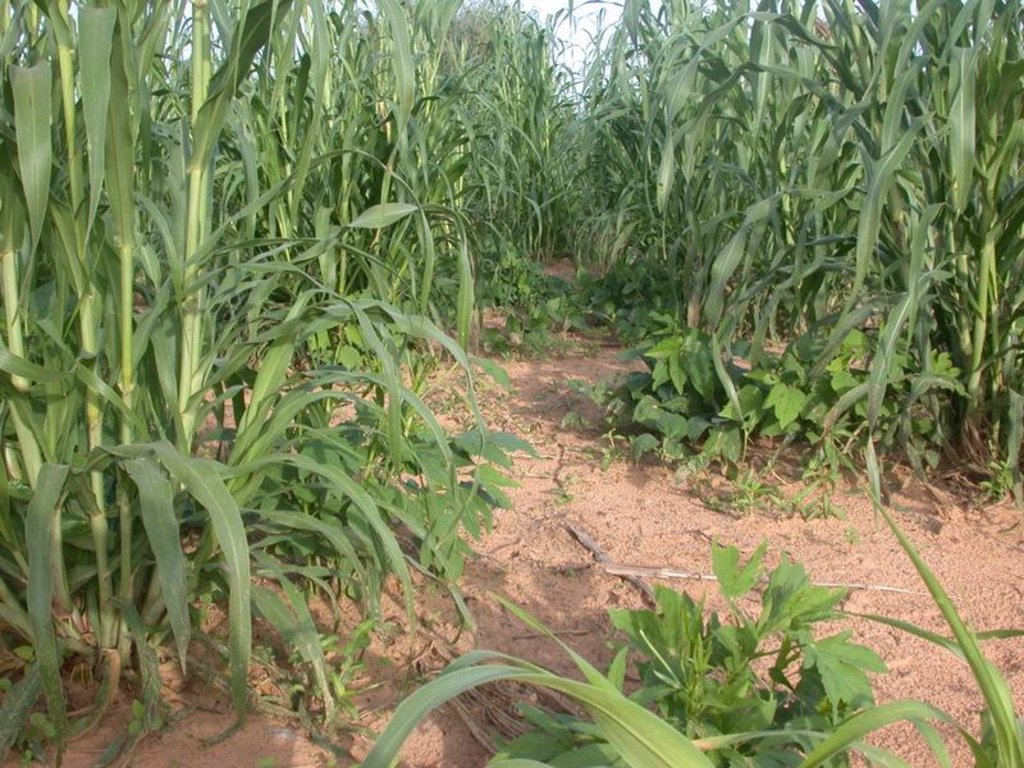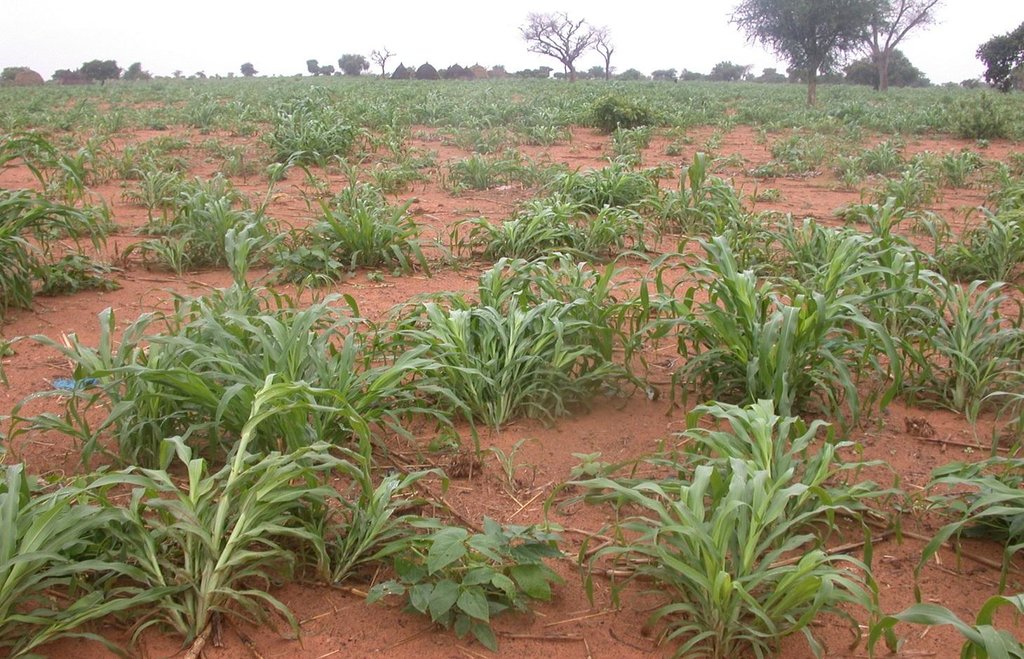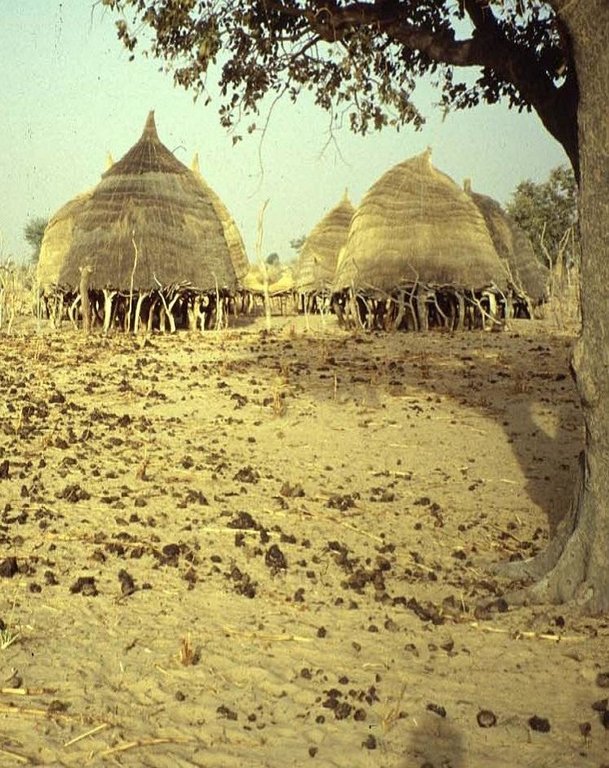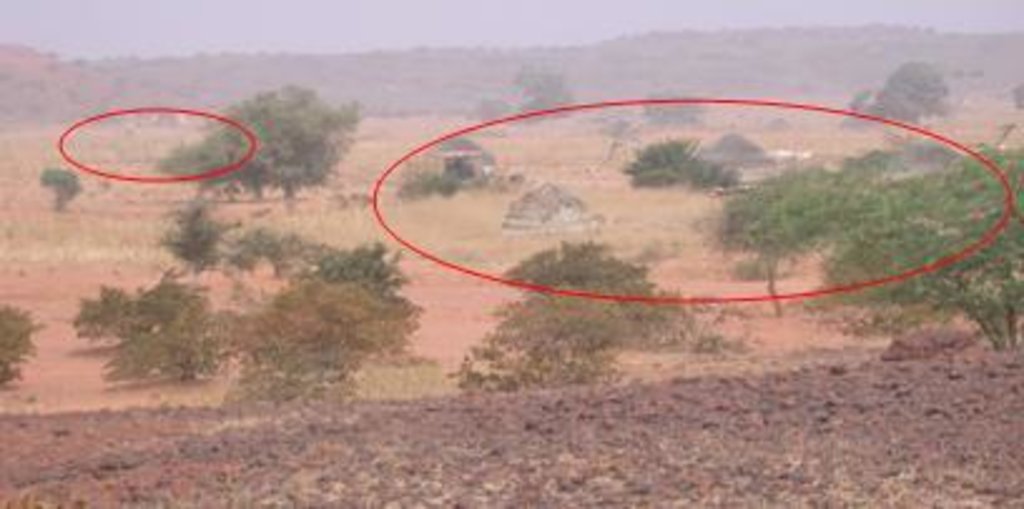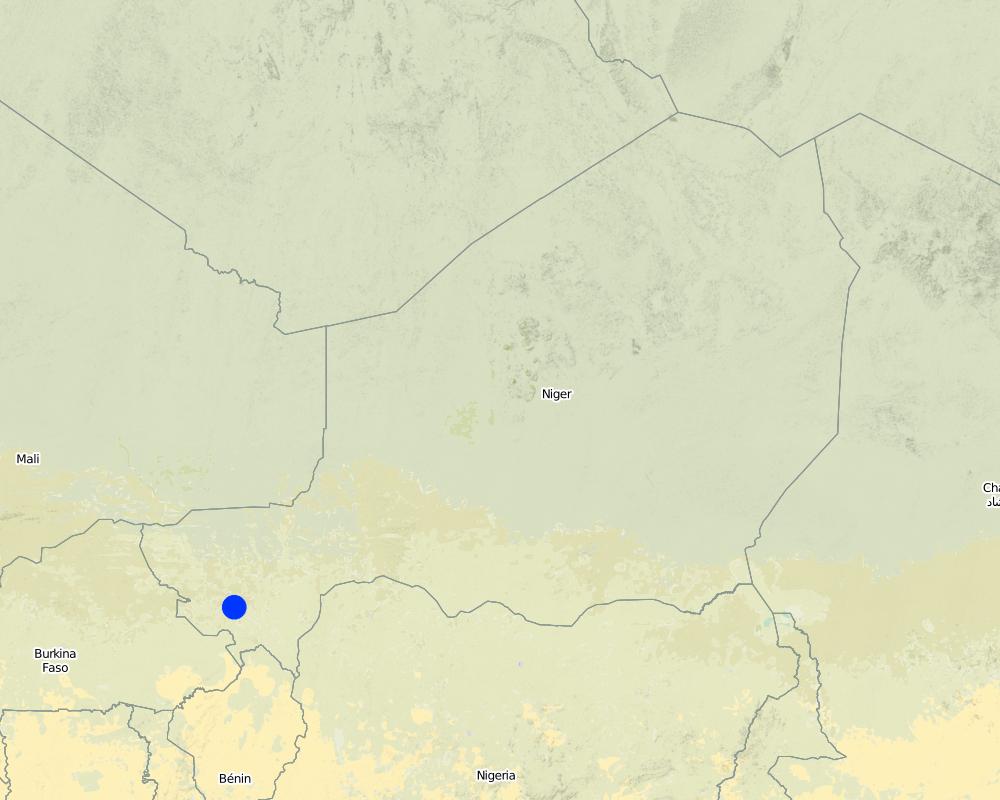Rotational Fertilization [尼日尔 ]
- 创建:
- 更新:
- 编制者: Julie Zähringer
- 编辑者: –
- 审查者: Alexandra Gavilano, David Streiff
technologies_953 - 尼日尔
查看章节
全部展开 全部收起1. 一般信息
1.2 参与该技术评估和文件编制的资源人员和机构的联系方式
有助于对技术进行记录/评估的机构名称(如相关)
GREAD (GREAD) - 尼日尔1.3 关于使用通过WOCAT记录的数据的条件
编制者和关键资源人员接受有关使用通过WOCAT记录数据的条件。:
是
2. SLM技术的说明
2.1 技术简介
技术定义:
Rotational fertilization is an integrated crop-livestock management measure practiced by the agropastoralist Peulh.
2.2 技术的详细说明
说明:
At intervals of 2-3 years the Peulh agropastoralists relocate with their livestock to a new area previously used for crop cultivation - where they install their temporary dwellings and improve soil fertility by applying farmyard manure and other organic materials.
The rotation of temporary habitation areas leads to successive fertilization of the land. Livestock (cattle or small ruminants) are corralled or tethered in the rehabilitation area over-night. They feed on crop residues and emerging grasses after harvesting of the crops. Dung dropped within the coral area is collected and then distributed on the fields. The main criterion for site selection is the level of land degradation. The size of the area occupied is maximum 500 m2, and depends on family size, herd size and on the quantitative and qualitative objectives of soil fertilization of the land owner.
In the years after settlement (after families move to a new location) the treated area is used for crop cultivation, and crop rotation/intercropping are practiced (e.g. millet/ legumes) for increased and diversified production, improved pest control and fertility management.
The effectiveness of this technology has led to field-fertilization contracts between agro-pastoralists and sedentary farmers. The farmers offer post-harvest grazing rights to the agropastoralists who in turn fertilize the land and benefit from the access to the important weekly markets in the area where they can sell milk. In this case the agropastoralist families and their livestock split up after the rainy season: a part assures fertilization of the own land, the other part is in charge of fertilizing foreign land (during 3-4 months) before returning home.
2.3 技术照片
2.5 已应用该技术的、本评估所涵盖的国家/地区/地点
国家:
尼日尔
区域/州/省:
Damari, Kollo District
有关地点的进一步说明:
Tillabéry Region, Niger
Map
×2.6 实施日期
如果不知道确切的年份,请说明大概的日期:
- 50多年前(传统)
2.7 技术介绍
详细说明该技术是如何引入的:
- 作为传统系统的一部分(> 50 年)
3. SLM技术的分类
3.1 该技术的主要目的
- 改良生产
3.2 应用该技术的当前土地利用类型

农田
- 一年一作
主要农作物(经济作物及粮食作物):
major food crop: Millet

牧场
粗放式放牧场:
- 半游牧/游牧
注释:
Major land use problems (land users’ perception): Soil fertility decline, soil erosion by wind and water
Livestock is grazing on crop residues
3.3 有关土地利用的更多信息
该技术所应用土地的供水:
- 雨养
3.4 该技术所属的SLM组
- 农畜综合管理
- 土壤肥力综合管理
3.5 技术传播
具体说明该技术的分布:
- 适用于特定场所/集中在较小区域
注释:
Total area covered by the SLM Technology is 1500 km2.
3.6 包含该技术的可持续土地管理措施

农艺措施
- A2:有机质/土壤肥力

管理措施
- M1:改变土地使用类型
注释:
Type of agronomic measures: manure / compost / residues
3.7 该技术强调的主要土地退化类型

土壤水蚀
- Wt:表土流失/地表侵蚀

土壤风蚀
- Et:表土流失

化学性土壤退化
- Cn:肥力下降和有机质含量下降(非侵蚀所致)
3.8 防止、减少或恢复土地退化
具体数量名该技术与土地退化有关的目标:
- 修复/恢复严重退化的土地
4. 技术规范、实施活动、投入和成本
4.2 技术规范/技术图纸说明
Technical knowledge required for field staff / advisors: (not applicable)
Technical knowledge required for land users: low
Main technical functions: increase in organic matter, increase in nutrient availability (supply, recycling,…)
Manure / compost / residues
Material/ species: farmyard manure and other organic materials
4.3 有关投入和成本计算的一般信息
注明雇用劳工的每日平均工资成本:
1.5
4.4 技术建立活动
| 活动 | 措施类型 | 时间 | |
|---|---|---|---|
| 1. | Identification of site where level of land degradation is high | ||
| 2. | Level and clean the land | ||
| 3. | Layout/disposition of infrastructure (dwellings, barns, corral, poles, poultry habitat) according | ||
| 4. | Establishment of infrastructure |
4.5 技术建立所需要的费用和投入
| 对投入进行具体说明 | 单位 | 数量 | 单位成本 | 每项投入的总成本 | 土地使用者承担的成本% | |
|---|---|---|---|---|---|---|
| 劳动力 | All the Labour | persons/day | 100.0 | 1.5 | 150.0 | 100.0 |
| 施工材料 | Lumber and straw for hut | ha | 1.0 | 100.0 | 100.0 | 100.0 |
| 技术建立所需总成本 | 250.0 | |||||
4.6 维护/经常性活动
| 活动 | 措施类型 | 时间/频率 | |
|---|---|---|---|
| 1. | On land being treated: on-going fertilisation by applying farmyard manure and any kind of organic material accruing from daily human activities to the soil during 2-3 years | 农业学的 | during 2-3 years |
| 2. | Maintenance/ re-location of huts to improve fertilization of land (after rainy season). | 农业学的 | None |
| 3. | On previously treated land: Land preparation (ploughing, e.g. cowpea). | 农业学的 | |
| 4. | Cultivation of millet and legumes ('niébé') as intercrop or in the form of crop rotation. | 农业学的 |
4.7 维护/经常性活动所需要的费用和投入(每年)
| 对投入进行具体说明 | 单位 | 数量 | 单位成本 | 每项投入的总成本 | 土地使用者承担的成本% | |
|---|---|---|---|---|---|---|
| 劳动力 | On-going fertilisation | persons/day | 10.0 | 1.5 | 15.0 | 100.0 |
| 技术维护所需总成本 | 15.0 | |||||
4.8 影响成本的最重要因素
描述影响成本的最决定性因素:
Establishment of housing infrastructure is done collectively, involving dozens of community members within less than a week. Construction material is taken from the woodlands; many parts are re-used after moving. While expenses are expressed in US$, in reality costs are in kind (mutual help) or not paid for (free lumber). Maintenance activities include: maintenance and re-building of dwellings. Costs for crop cultivation (US$ 335-535 annually) are not included.
5. 自然和人文环境
5.1 气候
年降雨量
- < 250毫米
- 251-500毫米
- 501-750毫米
- 751-1,000毫米
- 1,001-1,500毫米
- 1,501-2,000毫米
- 2,001-3,000毫米
- 3,001-4,000毫米
- > 4,000毫米
农业气候带
- 半干旱
Thermal climate class: tropics
5.2 地形
平均坡度:
- 水平(0-2%)
- 缓降(3-5%)
- 平缓(6-10%)
- 滚坡(11-15%)
- 崎岖(16-30%)
- 陡峭(31-60%)
- 非常陡峭(>60%)
地形:
- 高原/平原
- 山脊
- 山坡
- 山地斜坡
- 麓坡
- 谷底
垂直分布带:
- 0-100 m a.s.l.
- 101-500 m a.s.l.
- 501-1,000 m a.s.l.
- 1,001-1,500 m a.s.l.
- 1,501-2,000 m a.s.l.
- 2,001-2,500 m a.s.l.
- 2,501-3,000 m a.s.l.
- 3,001-4,000 m a.s.l.
- > 4,000 m a.s.l.
5.3 土壤
平均土层深度:
- 非常浅(0-20厘米)
- 浅(21-50厘米)
- 中等深度(51-80厘米)
- 深(81-120厘米)
- 非常深(> 120厘米)
土壤质地(表土):
- 粗粒/轻(砂质)
表土有机质:
- 低(<1%)
如有可能,附上完整的土壤描述或具体说明可用的信息,例如土壤类型、土壤酸碱度、阳离子交换能力、氮、盐度等。:
Soil fertility is low
Soil drainage / infiltration is good
5.6 应用该技术的土地使用者的特征
生产系统的市场定位:
- 生计(自给)
- 混合(生计/商业
相对财富水平:
- 贫瘠
个人或集体:
- 团体/社区
机械化水平:
- 手工作业
说明土地使用者的其他有关特征:
Land users applying the Technology are mainly disadvantaged land users
Population density: 10-50 persons/km2
5.7 应用该技术的土地使用者拥有或租用的平均土地面积
- < 0.5 公顷
- 0.5-1 公顷
- 1-2 公顷
- 2-5公顷
- 5-15公顷
- 15-50公顷
- 50-100公顷
- 100-500公顷
- 500-1,000公顷
- 1,000-10,000公顷
- > 10,000公顷
这被认为是小规模、中规模还是大规模的(参照当地实际情况)?:
- 小规模的
5.8 土地所有权、土地使用权和水使用权
土地所有权:
- 个人,未命名
土地使用权:
- 社区(有组织)
- 个人
注释:
Land use rights: individual, communal (organized)
6. 影响和结论性说明
6.1 该技术的现场影响
社会经济效应
生产
作物生产
饲料生产
饲料质量
畜牧生产
收入和成本
农业收入
社会文化影响
文化机会
社区机构
注释/具体说明:
Through mutual aid in technology implementation
SLM/土地退化知识
生态影响
土壤
土壤覆盖层
土壤流失
土壤有机物/地下C
生物多样性:植被、动物
生物量/地上C
动物多样性
减少气候和灾害风险
风速
其它生态影响
soil fertility
6.2 该技术的场外影响已经显现
风力搬运沉积物
对邻近农田的破坏
对公共/私人基础设施的破坏
6.3 技术对渐变气候以及与气候相关的极端情况/灾害的暴露和敏感性(土地使用者认为的极端情况/灾害)
渐变气候
渐变气候
| 季节 | 气候变化/极端天气的类型 | 该技术是如何应对的? | |
|---|---|---|---|
| 年温度 | 增加 | 好 |
气候有关的极端情况(灾害)
气象灾害
| 该技术是如何应对的? | |
|---|---|
| 局地暴雨 | 不好 |
| 局地风暴 | 不好 |
气候灾害
| 该技术是如何应对的? | |
|---|---|
| 干旱 | 不好 |
水文灾害
| 该技术是如何应对的? | |
|---|---|
| 比较和缓的(河道)洪水 | 不好 |
其他气候相关的后果
其他气候相关的后果
| 该技术是如何应对的? | |
|---|---|
| 缩短生长期 | 好 |
6.4 成本效益分析
技术收益与技术建立成本相比如何(从土地使用者的角度看)?
短期回报:
积极
长期回报:
非常积极
技术收益与技术维护成本/经常性成本相比如何(从土地使用者的角度看)?
短期回报:
积极
长期回报:
非常积极
注释:
The impact of the measure on soil productivity is increasing in the mid and long term
6.5 技术采用
注释:
There is a strong trend towards spontaneous adoption of the Technology
Comments on adoption trend: Its high effectiveness has helped spread the technology to adjacent areas on the other side of the river Niger, where farmers contract the agropastoralists for their ‘fertilization service’. The area covered by the technology is approximately 1'500 km2.
6.8 技术的弱点/缺点/风险及其克服方法
| 编制者或其他关键资源人员认为的弱点/缺点/风险 | 如何克服它们? |
|---|---|
| Growing costs and decreasing availability of timber and poles for establishment of infrastructure | re-introduce traditional techniques of long-term conservation of housing materials. |
| High labour input for implementation | reinforce community structures for mutual help. |
| Area treated by the technology is too small regarding the area in need of treatment (degraded land) | reinforce the solidarity between communities to increase the treated area. |
| Negative effect on the woodland (brousse tigrée): cutting for building materials, clearing for cultivation | identify new ecological materials for house construction; tree plantation. |
| Marginalization of families with low activity potential | reinforce mutual help systems to support poor / small families. |
7. 参考和链接
7.2 参考可用出版物
标题、作者、年份、ISBN:
Caroline Dandois Dutordoir (2006): Impact de pratiques de gestion de la fertilité sur les rendements en mil dans le Fakara (Niger), Université catholique de Louvain, 2006
标题、作者、年份、ISBN:
Bationo, A., Ntare, B. R. 2000 : Rotation and nitrogen fertilizer effects on pearl millet, cowpea and groundnut yield and soil chemical properties in a sandy soil in the semiarid tropics, West Africa. Journal of Agricultural Science, 134, p. 277-284.
可以从哪里获得?成本如何?
Journal of Agricultural Science, 134, p. 277-284.
标题、作者、年份、ISBN:
Ministère du développement agricole (2005): recueil des fiches techniques en gestion des ressources naturelles et de productions agro-sylvo-pastorales.
链接和模块
全部展开 全部收起链接
无链接
模块
无模块



